
Ayurveda believes that true beauty is composed of three vital elements: a well-nourished body, a balanced mind, and a peaceful spirit. We will be exploring this concept. We will look at different skin types (according to your dosha) , what changes in the skin lustre can signify, plus how we can heal through our senses.
Place – Yoga Sanctuary
Date 9th and 10th march – time midday to 1pm
Cost $20.00
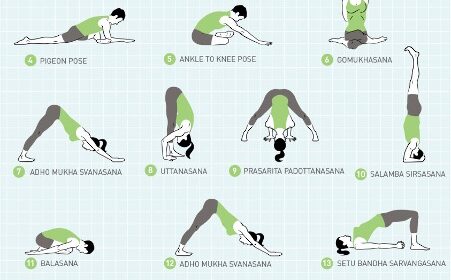
Ojas is a Sanskrit word meaning life sap, immunity, radiance, inner vitality, vigour, or life juice. It is the essential substance or essence of the body that protects and sustains us and determines our emotional, physical and mental health and happiness.
We build our ojas by feeding the tissues properly one layer at a time and by mindfully observing these practices.
Winter is the ideal season for nourishing the seven tissue layers of the body and building ojas. The healthy building up of these tissues is crucial to our longevity especially if we have become depleted through the year from disturbed metabolism, depression, mental stress, poor sleep, excessive indulgence and general prajnaparadhaor ‘crimes against wisdom’ as well as overuse of pharmaceutical drugs and other intoxicants. All these factors cause toxins to build in our body and we need proper digestion and rest to get us back on track and to maintain and build our vitality.
Wintertime is a beautiful opportunity for self-care. Our immunity is strengthened through rest and increased metabolic activity where we build our ojas. When our ojas is low and depleted we are beginning a cycle of compromised health but when it is strong, juicy and luscious we are setting ourselves up for a lifetime of inner and outer beauty.
We want to encourage relaxation, reduce stress and facilitate circulation throughout the body. These are the 3 most effective things that Yoga asana can do to support immune health.
Below is a restorative practise you can do at home
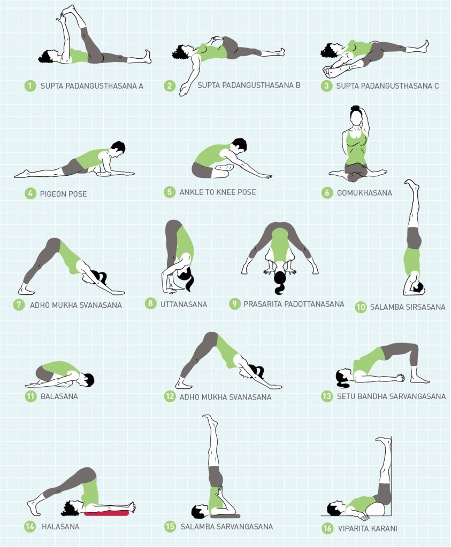

Ayurveda believes that true beauty is composed of three vital elements: a well-nourished body, a balanced mind, and a peaceful spirit. In this article I am going to concentrate on the aspect of a well-nourished body and the importance of digestion known in Ayurveda as Agni.
Most simply put Agni is the is the digestive fire that converts not only food, but sight, sound, feelings, and information into what makes up you ie your body, emotions and intelligence.
Problems arise when Agni is too high or too low. When too low or dull, there will be signs of gas, burping, slow transit time, scanty perspiration, constipation, cloudy mind and a dull complexion.
When too high there will be signs of belching, heavy perspiration, rashes, diarrhoea, burning sensations, plus irritability, and often red inflamed skin. Agni and Beauty
WHAT CAN BE DONE TO REGULATE THIS AGNI?

Pay equal importance to not only what you eat but how you eat – no matter what you eat, if you can’t digest it well you will not benefit from the food.
Conscious eating – yes eating is a sacred experience. You are taking in atoms and molecules that are to become part of your body.
Chewing is very important- food needs to be liquified before swallowing. If you don’t chew your food well, the rest of the digestive process will be compromised.
Take food and drink warm or at room temperature- in general warm slightly cooked food is digested easier.
Drink only a small amount of liquid with your food- water and other liquids help to moisten the food but too much will dilute the digestive enzymes and can alter the pH of the stomach acids.
Eat until 75% full – if you eat too much good food can become toxic and overwhelm the body. The right amount is when the body still feels light and the mind is clear. You should feel satisfied but not full.
Allow three hours or more between meals. Taking food before true hunger arises leads to poor digestion.
If there are signs of indigested food (known as Ama in Ayurveda) such as bad breathe, heavily coated tongue, gas, cloudy urine, digestive upset – it is best to give the system time to clear itself by fasting for day or at least skipping a meal until some sense of appetite occurs.
Try not to eat when angry, sad, depressed, upset or exhausted. Following some of these guidelines will assist with digestion and assimilation of our food that is the cornerstone for strong, well balanced and beautiful beings. This will translate as clear skin, bright eyes, glossy hair, strong nails, stamina and a happy and compassionate nature.
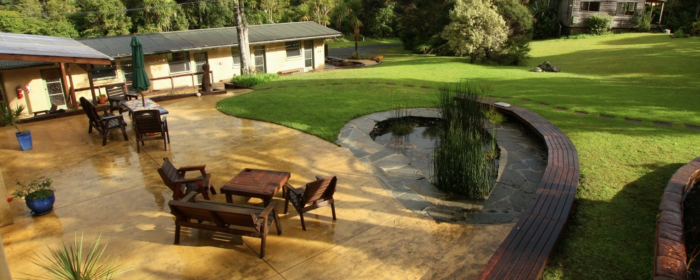
Schedule for upcoming retreat at Aio -Wira 22nd June
8 Aio Wira Road, Waitakere, Auckland 0781
Book now – click here
FRIDAY
Arrival anytime between 4 pm and 6.30 pm – when dinner will be served
7.30am Introductions talk about the programme.
Relaxation
Spa and sauna
SATURDAY
8am Meditation stretches and walk
9am Breakfast
10.00 to 11.30 am – Introduction to Ayurveda with a focus on digestion- Will include the importance of “agni and ama” and how this reflects in our skin and bodies, when out of balance. Will explore our own digestive power and what we can do in terms of lifestyle and food to rebalance.
12pm Lunch free time
2pm Kitchen help
Fermentation – a practical session where Di will take us through the steps of making sour dough bread, kefir, and sauerkraut
4.30pm Restorative Yoga
6pm Dinner
7.30pm Movie
Sauna and Spa
SUNDAY
8am Meditation stretches and walk
10am Perry will talk on the holy grail of a good poop – indications of good health and disease states. How we can remedy and assist healing using spices as the pharmacology.
12am Lunch
1.30pm Yoga Nidra
2pm Closing circle
Note: There will be on offer optional Ayurveda & hot stone massage treatments throughout the weekend.


Prana and its role In Ayurvedic healing – a common thread between Ayurveda and Yoga
Everything we do in life is a form of reception and transmission of energy. This involves not only eating and breathing, but also sensing, feeling and thinking. When I am accessing a persons health their vitality//life- force or Prana is one of the first considerations.
Recently I have had an injury and treatment involved going to several different therapists. This was an interesting experience – the clinical environment, the impersonal text book treatment was annoying and unsuccessful. When I experienced good rapport where the therapist could transfer some healing (spiritually energised prana) the difference was palatable.
It reinforced how important it is to create a loving save space for people to come when unwell. For everyone who comes for a treatment at Ayurveda Health, whether bodywork, Yoga or Health consultations, our aim is to make them feel better and more empowered by the time they leave.
Mantra
“I offer you peace.
I offer you love.
I offer you friendship.
I see your beauty.
I hear your need.
I feel your feelings.
My wisdom flows from the highest Source.
I salute that Source in you.Let us work together. For unity and peace.” – Mahatama Gandhi
All Ayurveda treatments from diet and herbs, to bodywork and meditation are ways of treating prana. The deep energy we extract from food is a vehicle for prana, herbs correct the movement of prana and touch is the sense through which prana is conveyed. Body work and yoga loosens pranic blockages and meditation opens the prana of the mind.
Behind most degenerative diseased states or those that are difficult to treat is chronic low energy or fatigue. Sometimes treating through diet and lifestyle is not enough and we have to look at other contributing factors such as shallow breathing, sensory perception, and proper association. To change we need to recognise and remove the factors that drain our energy. This can mean changing environments and negative relationships. When energy is chronically low we must be dissipating it or not renewing it properly.

There are several sources of energy. First there is your congenital (what you are born with) energy. Some are blessed with a strong constitution others are not. Kapha types tend to have the highest Ojas or immunity. Vata have the least, with Pitta in between.
Second there is the energy we bring in through the outside mainly through food and breathe. Devitalised foods and hurried or shallow breathing take their toll. Third are the factors that produce energy through the mind. Gossip, worry and excess thinking dissipate energy – mediation, mantra, silence and peace of mind increase mental energy.
Love itself is the highest and most nourishing form of prana. Love can keep people alive that would otherwise die. It can raise our prana from its deepest depths and therefore love has such a healing force.
Easy ways to raise your vibration.
Some suggestions to raise your vibration
- Find something of beauty every day and honor it. It may be a flower, a child’s smile or a beautiful painting
- Be grateful. Make a list and cultivate the attitude of gratitude
- Do something for someone else. Takes the attention of yourself and creates an aspect of abundance
- Stop complaining and gossiping
- Exercise- walk, yoga, get active. It has been proven that exercise releases endorphins that make us feel happier
- Listen to music – ancient chants are designed to alter your frequency
- Breathe – slow the breath down. This has a direct effect on the nervous system. A calm vibration is a higher vibration
- Meditate daily
- Hug someone or smile.
Let’s talk about asparagus
In early spring, your body starts to crave snappy and refreshing textures like fresh asparagus. Asparagus is a strong diuretic to relieve spring water retention. In Ayurveda, we see Asparagus as good for all doshas.
Sweet, astringent, bitter, cool, light and moist. It is ideal for Pitta. It stabilises Vata and lightens and stimulates Kapha. It can be steamed and eaten with grated ginger, lemon juice and a splash of good quality nut oil.
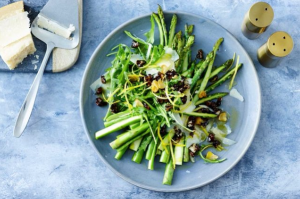
Endings
A few months ago I was in Fiji. Here I was reminded of the importance of connection where it is considered good manners to acknowledge total strangers on the street. Everyone is greeted and acknowledged through eye contact, a smile and by saying “Bu- la” It becomes 2nd nature and a basic human law -acknowledging the light in others. Easy to do… Let’s try…

I have been dying to write about the concept of “age” for awhile as the older I become the more apparent that our culture is so against the signs of aging such as wrinkles and grey hair – that mark our time of living on this planet. Insecurity often accompanies the physical changes that our body experiences along its natural journey through time. But why not love these marks of maturity along with everything else?
Much of imbalance in our culture comes in our failure to recognise the final stage of life and our inability to offer the elderly the appropriate tools for developing the higher consciousness that is naturally awakening in them. We deprive the elderly of their intrinsic wisdom and have little appreciation for the beauty and wisdom of the natural winter seasons of life.
Ayurveda literally means the “science of longevity”. Its offerings span not merely curing diseases, but maximising the life span, and providing optimal living. It recognises that we need time and space for spiritual growth in our later years. How we have really lived is reflected in how we age and how we die. Our elders reflect the fruit of our culture for good or for ill.
The body is said to mature around 21 years, the mind around the age of 30 but the soul does not mature until the age of 50, where the higher aspects of our life truly begin. Some cultures celebrate aging, seeing the passing of years as a sign of wisdom, evolution, and enhanced capacity for grace. I feel slightly shamed when we look at how the old are treated in the West.
Old age is the stage of life dominated by Vata, the biological humor, and its attributes of coldness, dryness, decay and disintegration. Whatever one’s constitution by birth, in old age we must consider anti-Vata treatment. Oil therapy both internally and externally becomes important. Tonification rather than reduction therapies become the primary focus along with tonic herbal foods and herbs. Ayurveda has so much to offer in these later years.
Yoga postures are important for maintaining flexibility of the joints and for preventing arthritis. They should be practised regularly. Pranayama is helpful in maintaining strength and vitality and strengthening the lungs. Meditation is essential for dealing with the aging process and for deeper contemplation on the meaning of life. I like to look into the eyes of older people – true beauty is apparent, often as the physical body shrinks – the soul shines. Let’s look for how much joy and compassion can a person hold? How much wisdom, love and vigour? This is the true measure of ageing well.
Below are pictures of my own mother aged 20 and then now in her late 80’s.
Can you still see her beautiful essence?

Herbs for the elderly
Chywanaprash is the best all round tonic for maintaining health and youth of tissues. It was originally devised for making the old feel young again and for helping yogis live and practice longer.
Gotu Kola is perhaps the best herb for improving hearing and memory
Ashwagandha is the main herb for maintaining strength of bones and joints. It strengthens immunity and is an excellent tonic all round.
Guggulu is the best herb for arthritic pain, as well as swelling & cracking of joints
Triphala treats constipation and helps rejuvenate the colon.
Recipe to love – warm up with spices
Spices in chai like cinnamon, cardamom, nutmeg, ginger all warm the body, stimulate digestion, and increase circulation. Many recipes are turned into warming tonics simply by adding spices. Here is my favorite chai and yes, it is perfect for everyone, (including the elderly). Nourishing and soothing on a fragile digestion.

1 cup of almond milk
(homemade-bought almond milk is often too watery)
¼ tsp cardamom
¼ tsp cinnamon
¼ inch fresh ginger
2 tsps ghee or coconut oil maple syrup to taste
Bring almond milk to a simmer, uncovered. As soon as the milk begins to simmer add spices and stand for 3-5 mins. Add oil or ghee and maple syrup.
Cooking Class – Cooking with Spices
On the subject of spices in the next month I will be running a session on “Cooking with Spices” that will cover the importance of inclusion for digestion. You will learn more about your own “agni” (digestion), kitchen remedies that can benefit, cooking healthy vegetarian food, and meeting like-minded people. The groups are small – limited to 8 people.
“I LOVED the cooking classes. Thanks very much for organising them. I feel so lucky to have stumbled across your website this year when feeling like my energy was never going to come up again. The skills you have, the knowledge that you willingly share, and your passion for Ayurveda incl yoga, meditation, nutrition and cooking are awesome. I’m very grateful to have benefited from them.”
To register your interest please email perry@ayurvedahealth.co.nz
My Thoughts
I suspect that the most powerful and basic way to connect to another person is to just listen. The most important thing we can offer another is our absolute attention. Especially if it is given from the heart. It has taken me a long time to realize that just saying “I am sorry” can be enough when someone is in pain. When you listen, without interrupting, people know you care. Loving silence…
A quote that resonates for me is:


It has been awhile since I have written a newsletter which is unusual for me.
This reflects the pace of my life.
In the month of June, I have been away a fair amount and one of those reasons was to attend a workshop on the microbiome and its effect on human health. There are 38 trillion cells making up the human microbiome – many more than cells in the body, so the flora plays a huge part in our overall health. These microorganisms play a big role in determining if we are healthy or sick. Diversity of gut flora is important, and this what we are losing through overuse of antibiotics and not enough fibre in our diet. A convincing and inspiration conference it explored the potential of a disrupted microbiome – that is the gut flora – and how it leads to an increase in intestinal permeability allowing endotoxins (waste products of the more parasitic bacteria) into the blood circulation that creates all sort of havoc. A lot of discussion around probiotics – as quoted by one of the worlds eminent probiotic researchers – Dr Reid…
You’ve got to know what they’re doing. Are probiotics really having an impact? What is the point of putting them in the same container if the strains inhibit one another?”
Certainly after 19 hours of lectures my thoughts on probiotics are that they will be more effective when prescribed by a qualified practioner to create the right effect. I certainly feel more confident in being able to advise in this area.
Modern science validates the Ayurveda Principle that all disease begins in the gut – and the first step is always to correct digestion. We are after all what we “digest, not necessarily what we eat”. *This newsletter focuses on a common gut condition – constipation, which is a main digestive system disorder, resulting in retention of waste materials in the body, affecting our vitality and health.
*Also included is a recipe for a warming & nourishing green soup providing nutrients galore.
*Featured products that can assist with a “lazy” bowel – Triphala and Bowelcare.
Constipation and general treatment
 The most common condition I see in the practise is Constipation. It reflects that elimination is not occurring and therefore the ability to be fit, healthy and vital is compromised. Constipation is diagnosed when there are less than 3 bowel motions per week. Other symptoms are hard stools that are difficult to pass, or a sensation of incomplete evacuation. Ideally one should have an easy bowel motion first thing in the morning. The stool should be soft, easy to past, well- formed and float. Often accumulation of toxins is indicated by a thick coating at the back of the tongue. Ayurveda considers constipation as mainly a Vata disorder, particularly when it is a long standing. Causes are typically dietary with too much dry or light food, irregular eating habits, medication, sedentary lifestyle and lack of fluids. Psychological factors such as insomnia, worry, grief and fear may also be a contributor. For any form of constipation that is not severe the first step is to improve digestion with the right use of spices to normalise the agni or digestive fire. Ginger, cumin and fennel are all excellent choices. Herbs such as Triphala which tones and strengthens the colon are preferable to purgatives. Consisting of 3 berries Triphala nourishes the bones and nerves and increases general well-being. It helps to push out water-soluble toxins through the lymphatic system and the kidneys, as well as to remove the accumulated toxins that causes an overgrowth of the bad microorganisms in the GI tract. Triphala is considered a rejuvenative formula, so it not only helps to treat diseases, but it helps to promote health.
The most common condition I see in the practise is Constipation. It reflects that elimination is not occurring and therefore the ability to be fit, healthy and vital is compromised. Constipation is diagnosed when there are less than 3 bowel motions per week. Other symptoms are hard stools that are difficult to pass, or a sensation of incomplete evacuation. Ideally one should have an easy bowel motion first thing in the morning. The stool should be soft, easy to past, well- formed and float. Often accumulation of toxins is indicated by a thick coating at the back of the tongue. Ayurveda considers constipation as mainly a Vata disorder, particularly when it is a long standing. Causes are typically dietary with too much dry or light food, irregular eating habits, medication, sedentary lifestyle and lack of fluids. Psychological factors such as insomnia, worry, grief and fear may also be a contributor. For any form of constipation that is not severe the first step is to improve digestion with the right use of spices to normalise the agni or digestive fire. Ginger, cumin and fennel are all excellent choices. Herbs such as Triphala which tones and strengthens the colon are preferable to purgatives. Consisting of 3 berries Triphala nourishes the bones and nerves and increases general well-being. It helps to push out water-soluble toxins through the lymphatic system and the kidneys, as well as to remove the accumulated toxins that causes an overgrowth of the bad microorganisms in the GI tract. Triphala is considered a rejuvenative formula, so it not only helps to treat diseases, but it helps to promote health.
Castor oil in ginger tea taken at night is excellent for severe constipation as it is not drying to the colon, bringing a snehana (lubricating action). Yoga postures such as forward bends and abdominal twists that focus on moving the stomach and intestines in all directions to aid the digestion process. This stimulates the flow of blood to all parts of the intestines and generally helps food pass through easier. Ensure that the diet has an adequate intake of oily and bulk foods. These include dairy products, nuts, whole grains, juicy fruits and good quality oils. Don’t forget the fluids!!
Featured Products
Bowelcare facilitates bowel movements helping to remove toxins and waste. It seems to assist in regulation of peristalsis and I have used in treating IBS quite successfully. It contains three well known and loved herbs used regularly in India. Bael leaf (Aegle marmelos), Garden Cress seeds (Lepidum sativum), and psyllium husk (Plantago ovata) combined to create a formula gentle enough for everyday use and effective in balancing the digestive tract. Bowelcare combines well with Triphala.

Triphala is a herbal bowel cleanse and very useful for constipation. It aides in the elimination of intestinal toxins and gas. It improves digestion and helps to regulate metabolism. Good for people of all ages, it can be taken long term. Triphala is considered a rejuvenative formula, so it not only helps to treat diseases, but it helps to promote health. It’s called a rasayana, an herbal formulation that helps to promote health long-term. Ingredients are three berries – Amalaki, Vibhitaki and Haritaki. It is available from the clinic in powder and capsule form.
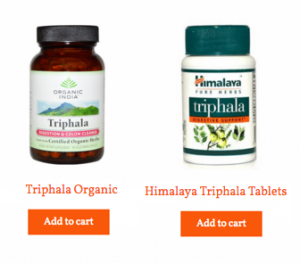
Detox Healthy Green Soup
▪ 3 cloves garlic, minced
▪ 1/2 zucchini, sliced
▪ 1 small kumera
▪ 1– 1 ½ tsp. cumin
* 1 tsp coriander
▪ 1 tsp. salt
▪ ½ tsp turmeric
▪ 2 cups of chopped greens, such as kale, spinach, swiss chard, mustard greens, packed.
▪ 4 cups of vegetable broth
▪ ½ c. loosely packed cilantro
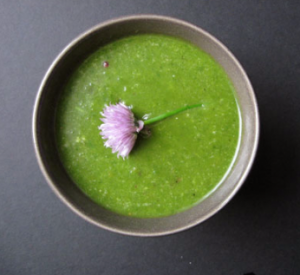
Directions
Heat a large stock pot over medium-low heat until hot and add the zucchini, sliced kumara, garlic and spices
Add the greens gradually, you will have to add them 1 handful at a time, stirring and letting them cook down to add more. (Add spinach last as it takes the least amount of time to cook down)
Add the cilantro and cover, bringing to a boil, then reduce the heat to simmer while covered and cook for about 20 minutes until greens are completely soft.
Remove from the heat. Blend until smooth Adjust the seasonings if necessary, and return to simmer, 15 more minutes. Add a squeeze of lemon and then serve!
Wisdom
We all have choices as we walk through out life. I remember hearing this teaching right at the beginning of my meditation journey (over 30 years ago) and it has always stuck
The Two Wolves
One evening an old Cherokee told his grandson about a battle that goes on inside people. He said, “My son, the battle is between two wolves inside us all.”
“One is Evil – It is anger, envy, jealousy, sorrow, regret, greed, arrogance, self-pity, guilt, resentment, inferiority, lies, false pride, superiority, and ego.”
“The other is Good – It is joy, peace, love, hope, serenity, humility, kindness, benevolence, empathy, generosity, truth, compassion and faith.”
The grandson thought about it for a minute and then asked his grandfather, “Which wolf wins?”
The old Cherokee simply replied, “The one you feed.”
Namaste Perry

Ayurveda Health April Newsletter 2017
– Autumn – transitioning with the seasons- looking after the Vata dosha
– Food is the Perfect Medicine.
– Dr Vijay Murthy – a fantastic opportunity to attend a workshop on the topical subject of Intermittent fasting…a few “one on one” consultations (with Dr Vijay Murthy) offered on the 11th May
– Restorative/Yin practice/Meditation practice – new 6-week course starting (Yoga Tree in Takapuna) Tuesday 2nd May
– Recipe – Spiced Lentil soup with Coconut Milk
Quote I love …
The seasons are shifting …the days are becoming shorter and the temperatures are becoming colder. You can really feel the transitions of the seasons and it is a time when we become a little more vulnerable.
“Real flowers are much more beautiful than plastic ones, in part because of their impermanence. We appreciate the seasons, the autumn and the spring, because they are a process of change. In this way, impermanence is beauty.” – Chögyam Trungpa
As the seasons change so does the dominant dosha in our immediate environment. In the fall Vata increases and this tends to make people, especially Vata types, more prone to symptoms like constipation, sore and dry throats, excessive dry skin, anxiety, sciatica and increased insomnia. The word Vata means to move and this is an important clue to the character of the Vata individual. Vata regulates all activity in the body; from the number of thoughts we have, to how quickly and efficiently food moves through the digestive tract. The behavior that Vatas are drawn to – erratic hours, travel, frequent change, and excessive movement – can easily upset their balance. Excessive vata makes the mind restless and hyperactive. Like the wind the vata types have a hard time feeling grounded, when their Vata becomes aggravated. Sticking to a routine is difficult for them, but is vital for them to remain healthy. To decrease vata, Ayurveda has given us dietary, lifestyle and herbal treatment strategies. Here are a few underlying concepts that these strategies are based on:
– Routine
– Warmth
– Serenity
– Nourishment
Have a look at products that help keep Vata in balance – click here
Food is the perfect medicine.
In Ayurveda Food is the number one focus in healing. We know that food builds, fuels and repairs every cell in the body, and by means of the subtler energies it also fuels and heals our emotions. What you eat is as important to your mental health, as it is to your physical health.
Ayurveda recognizes that we are all so different and that “one shoe does not fit all.” All foods are classified according to taste; Virya i.e. heating or cooling effect; the dominant quality (guna) of the food eg drying, oily etc. The principle of strength of digestion and the amount of toxins on the body, are always taking into consideration. A good example of right diet wrong person, would to treat a Vata dominant person with all raw food and juices for long periods of time. This would eventually increase the Vata through the cold, astringent, and drying action of the food. Raw is Ok for detox, but generally for Vata people, they require more warm and unctuous foods. To treat a person’s health without careful regard to diet is like tending a garden without checking the soil and amount of sunshine and water it receives. . Good food leads to good health and mental well-being.
Intermittent fasting – workshop with Dr Vijay Murthy May 10th
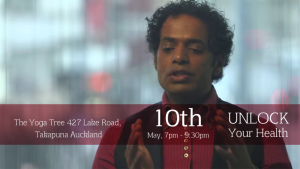 We are so excited and honored to have Dr Vijay visit NZ in May. During this time he will be offering his expertise on a topical subject. Intermittent fasting as the most effective solution for:
We are so excited and honored to have Dr Vijay visit NZ in May. During this time he will be offering his expertise on a topical subject. Intermittent fasting as the most effective solution for:
Fertility issues
Thyroid problems
Menopausal symptoms
Cancer
This will include how to fast and how not to. Traditional ways of fasting and the scientific evidence on medicinal fasting. His bio is impressive view here – click and I really encourage you to try and make his talk. You will learn a lot as he is a great communicator. There will be allocated time for questions. Details are as follows – View Facebook Event – Click Here
In addition to this he will be allocating the next day – Thursday 11th May Vijay will be offering – one on one consultations. These will be held here at Ayurveda Health in Milford. There are a few spaces left in the afternoon If you wish to book please email me perry@ayurvedahealth.co.nz. It will be a case of “First in first served”.
Yoga – Restorative class moving into lead meditation…(yes it is good for vata)
We are offering a “restorative class moving in to meditation” again starting for 6 weeks in May.
Tuesday evenings from May 2nd – 7.00pm to 8.15 pm
A very nourishing form of Yoga that benefits all people (there is no need to have had any prior yoga experience).
All people are very welcome. Register online: www.theyogatree.co.nz
Spiced Lentil Soup with Coconut Milk –
Note this recipe serves about 6 people.
We have made this recipe in our cooking classes and I am feeling like eating this warm and nourishing food again. Very yummy and perfect for the coming colder months. The recipe calls for green lentils. Split or red lentils will likely get too mushy here. I used 4 cups broth because I like my soups on the stewy side, if you prefer more broth to you soup, add another cup or two when cooking the lentils.
1 1/2 cup lentils, rinsed (green suggested)
4 cups low sodium vegetable broth
1 1/2 tsp. turmeric
1 tsp cumin and coriander powder
2 tsp. dried thyme
1 Tbsp. coconut oil
1 large red onion, diced
2 stalks lemongrass, outer layer removed, lower portion finely minced
1 tsp. sea salt, plus more to taste
1/2 tsp. cardamom
1/2 tsp. cinnamon pinch of red pepper flakes to taste
Pinch of fresh grated nutmeg
1 1/4 cup coconut milk (use full fat, just believe me)
3 Tbsp. lemons, lime or orange juice
A few handfuls of swiss chard, spinach or kale
1 cup flake coconut, toasted (optional)
Chopped cilantro, for garnish (optional)
Add the rinsed lentils, broth, thyme and turmeric , cumin and coriander powders to a large pot. Bring to a boil, turn down to a simmer and cook for about 20 minutes.
While the lentils cook, heat the coconut oil in a pan. Add the onion and sauté until just browned. Add the lemongrass, salt, cardamom, cinnamon, pinch of red pepper flakes and some fresh ground nutmeg and sauté another minute. Add the onion mixture to the lentils and stir, keeping the heat on a low simmer. Add the coconut milk and greens and simmer another five minutes, stirring occasionally until just wilted. Taste for salt and spice and add, as you prefer. Finish with the citrus juice and serve warm with toasted coconut flakes and cilantro on top.
A thought plus a quote…
Intuition, intention, awareness, acceptance are cornerstones in creating lasting change. On and off the Yoga mat, these principles enable us to let go of old patterns and ways of being.
• Our thoughts become our words
• Our words become our actions
• Our actions become our habits
• Our habits become who we are.
Namaste Perry

“Most people work hard and spend their health trying to achieve wealth. Then they retire and spend their wealth trying to get back their health.”
Your body is designed to preserve its own health. It is constantly replenishing its cells. Every second, several million red blood cells are removed and replaced from your circulatory system. Every five days your stomach lining is renewed. Every thirty days, you have a brand new protective skin. Every ninety days, your body turns over all the molecules that make up your bones.
Why do we not get well?
If one has clogged blood vessels or intermittent headaches, it won’t necessarily be obvious to see how acrylamides in crisps, casein in pasteurised and homogenised dairy, free radicals in cheap vegetable oils, sugar, aspartame, and the multitude of other disease-causing compounds found in our diet are injuring our cells internally.
With the abundance and endless varieties of foods available from our supermarkets why is it impossible to feel nourished by what we buy?
It is simple …. nature is not in command. Often our foods are sweetened, emulsified, stabilized, salted, irrigated, bleached, blanched, polished, degermed, sprayed, anti-spoiled… By the time some of the food reaches our tables it is loaded with more chemicals than a chemist shop. Additionally, it is hard to observe the damage that stress-related compounds released because of anger or anxiety does to our organs. What happens to our energy stores when we act against our own values or respond out of fear? Where does our “moral compass” come into play when preventing illness or getting well.
We all know about good food choices, good lifestyle choices, exercise, sunlight, positivity and stress-coping techniques, – but it can be hard to remain focused and motivated when you can’t see the effects of our choices in real-time. I am always so surprised when people expect immediate relief in conditions that have taken years to manifest. Most alternative therapies require some form of self-responsibility.
What Then Does It Take To Stay Healthy? Everyone in today’s World who wants to be healthy, has a personal responsibility to learn as much as possible about health.
We have a huge amount of information available to us, which can be very confusing and overwhelming. Ayurveda teaches us to take personal responsibility by experiencing ie you need to participate in Ayurveda to understand it. In Ayurveda food and actions are the keys to healing. We hear a lot about food but not so much about actions (and how energetically they can affect us).
Ayurveda can’t prevent someone from aging or death. But it can strengthen body and mind to make the journey of life more enjoyable. The Ayurveda perspective is to get away from the idea of quick fixes that is so firmly entrenched in our culture. Most healing takes time and commitment. We need to heal not only the body, but mind and spirit. Both Yoga and Ayurveda aim in gradual and natural deep internal changes. Not forced or superficial. Below are some tips that I hope you find useful.
Recipe of the month.
I very much enjoy the fresh chutneys to add digestive power, but also taste to foods such as Risottos or other rice or meat dishes, that need a little zing. In Ayurveda Beetroot are best for Vata constitutions because they are sweet in taste, warm, moist and add mass.
However, for Pitta types a small amount of juice can be therapeutic for liver conditions. The medicinal properties of Beetroot utilized in Ayurveda are for uterine disorders, constipation and hemorrhoids. As beetroot are economical and still in season, this is an easy and appropriate recipe to try.

Beetroot Jam
Blend one large boiled and skinned beetroot with 1 tsp each of toasted cumin seeds, coriander seeds and black peppercorns.
Sauté 1 small red onion 2 cloves of garlic and 2 green chilies.
Add 1 tsp salt, 30 grams fresh coriander, 1 tblsp Tamarind sauce, a tomato (skinned) and the juice of one lemon.
Combine and serve fresh – Delicious ….. a bit hot & spicy for the Pitta digestion but good for stimulating Kapha & warming Vata
Featured Product – B ramhi Vati
ramhi Vati
When do I think of Bramhi Vati – anytime we have that feeling of brain fog, or just lack of mental clarity. Good to use before exams or when highly stressed and “can’t think straight.”
Bramhi Vati – A traditional Ayurveda formulated product containing Bramhi, Ashwagangha and shankapusphi herbs. Click here to buy now.
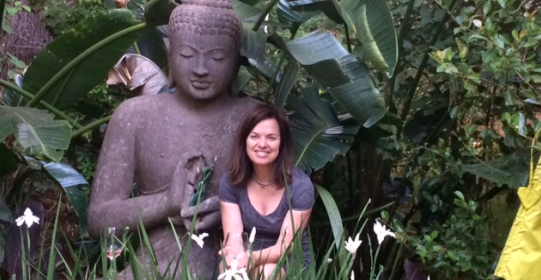
Laying the Foundation for your health…
I have focused this newsletter on vibrational energy and health. Prana (life-force) is the common thread between Ayurveda and Yoga. It includes some suggestions that we can apply to increase our “vibration” and why slow Yoga works. Also, a recipe that is yummy and healthy – good for this time of year – plus a quote that resonates with me. Here’s to 2017 – may we be peaceful, loving and courageous.
Ways to raise your vibration –
We all know what it is like to be happy. We literally feel lighter and more expansive. The happier we are the more we will invite happier experiences as we are operating at a different frequency. When we are unhappy we feel heavy and denser. Sometimes just checking in as to how we are feeling will alter our vibration. Perception always starts with awareness.
Some suggestions to raise your vibration
- Find something of beauty every day and honor it.
It may be a flower, a child’s smile or a beautiful painting.
- Be grateful. Make a list and cultivate the attitude of gratitude.
- Do something for someone else. Takes the attention of yourself and creates an aspect of abundance
- Stop complaining and gossiping
- Exercise- walk, yoga, get active.
It has been proven that exercise releases endorphins that make us feel happier
- Listen to music – ancient chants are designed to alter your frequency.
- Breathe – slow the breath down. This has a direct effect on the nervous system.
A calm vibration is a higher vibration.
- Meditate daily
- Hug someone or smile.
 Removing Density from your body – why slow yoga
Removing Density from your body – why slow yoga
Because of stress, poor diet, lack of movement, aging and emotions, the body can become very dense. When the body becomes dense, it becomes very stiff and rigid. The body’s life force or prana, which moves through every cell of the body, cannot do so fluidly in the presence of a dense physical body. One of the purposes of yoga asana (poses) is to help break up the density of the physical body, thus allowing the prana to flow more freely. For this to happen, the posture needs to be held for an extended period. This is where restorative and Yin yoga comes in. Long holds allow the muscles to begin to relax.
If you hold a posture for just 15-30 seconds, the tendons – the attachments where the muscles connect to the bone – tighten in resistance to the stretch. If the posture is held for 2 minutes or more, the belly of the muscle where all the blood – and with it the potential elasticity – are found will begin to release and lengthen. Lengthening the belly of the muscle is like putting elastic links in a chain – the result is more permanent elasticity and flexibility.
With greater muscle flexibility and elasticity, the prana can begin to mod help break up the subtle mental, emotional and energetic blocks in the body. Per the Ayurveda philosophy there are 72,000 nadis or subtle energy channels in the body. Once the Prana begins to move, through slow yoga, breathe, meditation and a balanced lifestyle, the nadis become activated and our bodies do feel less dense. Don’t get me wrong, I love and support all types of Yoga, but more and more see the benefit or a restorative practise.
Yoga Classes
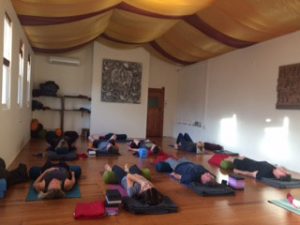
If you would like to experience a mix of restorative, Yin and meditation … there is a course starting at:
The Yoga Tree in Takapuna on Wednesdays 6.45pm to 8.00pm from the 1st March up to and including the 12th April.
Click here to book now
Why have an Ayurveda Consultation?
The beginning of the year is a good time to review your health and be inspired to make change for the better. Ayurveda is a fantastic preventative medicine. Once the basic principles are understood you can take responsibility for your own well-being by increased awareness as to what makes you feel better and what makes you happy.
If you have not already considered an Ayurveda consultation as a good launching pad to improve your health. (There is a 20% discount this month if you book by the end of February).
Make a booking – click here
Recipe for the summer months…
The recipe I am enjoying is… Persian Cucumber Salad
It makes for a complete meal in itself, and once your potatoes are cooked, it comes together rather quickly. Recipe below…

Newsletter – November/December 2016
Living according to the season – the summer months

How I love summer. The sun is out, the days are longer, we can spend more time outside, and most of us feel generally happier and healthier.
In Ayurveda we see it as a time when the fire element is increased, there is more warmth, lightness and dryness. These are qualities that increase Pitta and can also increase Vata.
If we are of dominant Pitta constitution it is even more important to adjust your routine to cater for the change in weather. Pitta can build up in the digestive system, liver, eyes, skin, and heart at this time of year. This can result in conditions such as diarrhea, inflamed and red skin, sensitive eyes, hypertension, anger and frustration.
Here are some Ayurveda suggestions for your summer routine
- A light massage with room temperature coconut oil* (or Pitta reducing oil) nourish the skin and clear any heat. Wash this off with cool water.
- Your diet in the summer should consist of sweet, bitter, astringent flavors and be light and easy to digest.
- In the summer it is best to avoid all dark meats such as beef, lamb and pork as well as citrus fruits, tomato, garlic, onion, salt and sour dairy products as these all increase pitta.
- Coffee and alcohol should be avoided (or at less limited)
- Utilise the cooling herbs – cumin, coriander, fennel, peppermint leaves and mint as digestive herbs (pitta digest) – link
- When you are thirsty try drinking cool herbal teas of peppermint, licorice, fennel and rose. Limes are also very cooling.
- Before you go to bed, especially if it has been a hot day, rub the soles of your feet with *Bramhi oil to bring all the heat down to your feet
- Spray your face with *organic rose water “during the day or before going to bed– very cooling Suggested Yoga Practise to reduce Pita
- Start your yoga practice with some cooling and calming Sheetali pranayama- this is an especially calming and soothing practice where you roll your tongue into a tube and then draw the air in through this tube and out through your nostrils. You can just feel the cool air chilling you out!
- Pitta can accumulate in the digestive system, especially the liver and small intestine. Do some abdominal stretches and abdominal twists for helping to clear pitta from your belly. Try Trikonasna (triangle series), Bhujangasana (cobra), Matsyendrasana (twist), Ushtrasana (camel).
- It is important to not do too many inverted poses (esp headstand) as these bring heat up to your head if you are already a bit of a pitta prone person or are suffering from hypertension.
- After yoga anoint yourself with some sandalwood or rose oil. Place a drop on your third eye, throat and navel to keep these centers cool and calm.
Lets talk about Asparagus
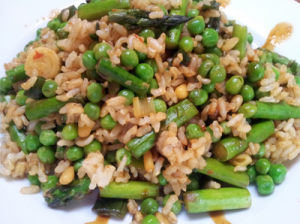
I love Asparagus and have been munching my way through, many stalks, as the season is short lived in NZ Asparagus, in Ayurveda is one of the few vegetables that can be eaten by all doshas with no aggravation. Sweet, astringent and bitter, cool light and moist, it is ideal for Pitta. It stabilises Vata, being easy to digest, and lightens Kapha. Medically it can be used as a slight laxative, nerve sedative, general tonic and demulcent.
That aside it tastes delicious just steamed with a dash of ghee, some grated fresh ginger, black pepper and Himalayan salt to taste. In writing this newsletter I came across this recipe – It is a take on the kitchari recipe given last month utilizing Asparagus as the main vegetable. Have a look – it’s healing and delicious.
I have made two huge batches of this stew in the past 3 months and am not tired of it at all. Enjoy something new!
- 1 teaspoon ghee (I substituted olive oil)
- 1/8 teaspoon saffron
- 1/2 teaspoon ground cumin
- 1/2 teaspoon ground fenugreek seeds
- 1/2 cup finely chopped leeks (wash carefully – white parts only)View recipe – click here
Featured Herb – Amalaki (also known as Amia)
How I love this herb…Being Pitta in nature I have first hand felt the benefit of Amalaki. It is very beneficial for the heart of the body and also the emotional heart promoting longitivtiy. It is the best single herb for controlling Pitta being a front line anti-inflammatory herb. The fruit is very high in Vitamin C and hence a powerful anti oxidant. It is used to treat hemorrhoids, gout, gastritis, colitis, liver or spleen disorders, premature greying, hair loss, and palpitation. Can be bought in caps or powder and is the key ingredient in last months featured product Chyavanprash
Rose the cooling flower
Roses are coming into full bloom…here are a couple of recipes that you can utilize to make the most of the petals… It would be appropriate to mention that 1,400,000 hand picked petals are required to produce 1 liter of rose oil (that equates to 67 blossoms to give one drop). We need to remember these statistics and savor and appreciate each drop of oil as a gift of healing.
Rose Water Toner
You will need:
- 1 cup organic rose petals,
- 2 cups boiling filtered water
- and 1 spray bottle
Place the rose petals in a pot or metal bowl. Cover the petals with boiling water and soak for around 1 hour.
Strain and pour the rose water into a spray bottle. Store in the fridge. Rose water is slightly astringent, cooling and great for sensitive skin.
Some thoughts…
Ayurveda does not separate Mind and body. We see good health as not just a absence of disease but the ability to be the best that we can possibly be. Emotions have an effect on our health and you will see in the following graphic, emotions traditionally associated with particular organs. Sometimes eating right and exercising is not enough we have to look at our ability to feel and greet our emotions – both good and bad. Carl Jung said “One does not become enlightened by imagining figures of light but by making the dark more conscious. “By facing our emotions we can explore them and develop more resilience This is where mindfulness and meditation have a role – reflection and self-study all play their part in healing.









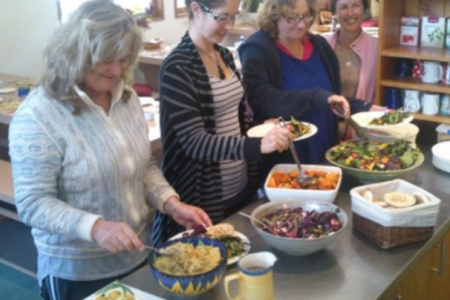









 The most common condition I see in the practise is Constipation. It reflects that elimination is not occurring and therefore the ability to be fit, healthy and vital is compromised. Constipation is diagnosed when there are less than 3 bowel motions per week. Other symptoms are hard stools that are difficult to pass, or a sensation of incomplete evacuation. Ideally one should have an easy bowel motion first thing in the morning. The stool should be soft, easy to past, well- formed and float. Often accumulation of toxins is indicated by a thick coating at the back of the tongue. Ayurveda considers constipation as mainly a Vata disorder, particularly when it is a long standing. Causes are typically dietary with too much dry or light food, irregular eating habits, medication, sedentary lifestyle and lack of fluids. Psychological factors such as insomnia, worry, grief and fear may also be a contributor. For any form of constipation that is not severe the first step is to improve digestion with the right use of spices to normalise the agni or digestive fire. Ginger, cumin and fennel are all excellent choices. Herbs such as Triphala which tones and strengthens the colon are preferable to purgatives. Consisting of 3 berries Triphala nourishes the bones and nerves and increases general well-being. It helps to push out water-soluble toxins through the lymphatic system and the kidneys, as well as to remove the accumulated toxins that causes an overgrowth of the bad microorganisms in the GI tract. Triphala is considered a rejuvenative formula, so it not only helps to treat diseases, but it helps to promote health.
The most common condition I see in the practise is Constipation. It reflects that elimination is not occurring and therefore the ability to be fit, healthy and vital is compromised. Constipation is diagnosed when there are less than 3 bowel motions per week. Other symptoms are hard stools that are difficult to pass, or a sensation of incomplete evacuation. Ideally one should have an easy bowel motion first thing in the morning. The stool should be soft, easy to past, well- formed and float. Often accumulation of toxins is indicated by a thick coating at the back of the tongue. Ayurveda considers constipation as mainly a Vata disorder, particularly when it is a long standing. Causes are typically dietary with too much dry or light food, irregular eating habits, medication, sedentary lifestyle and lack of fluids. Psychological factors such as insomnia, worry, grief and fear may also be a contributor. For any form of constipation that is not severe the first step is to improve digestion with the right use of spices to normalise the agni or digestive fire. Ginger, cumin and fennel are all excellent choices. Herbs such as Triphala which tones and strengthens the colon are preferable to purgatives. Consisting of 3 berries Triphala nourishes the bones and nerves and increases general well-being. It helps to push out water-soluble toxins through the lymphatic system and the kidneys, as well as to remove the accumulated toxins that causes an overgrowth of the bad microorganisms in the GI tract. Triphala is considered a rejuvenative formula, so it not only helps to treat diseases, but it helps to promote health.








 Removing Density from your body – why slow yoga
Removing Density from your body – why slow yoga


